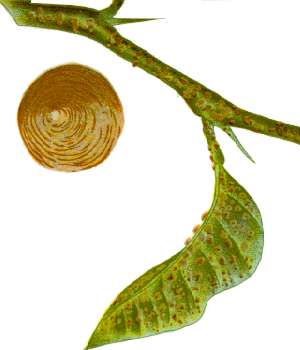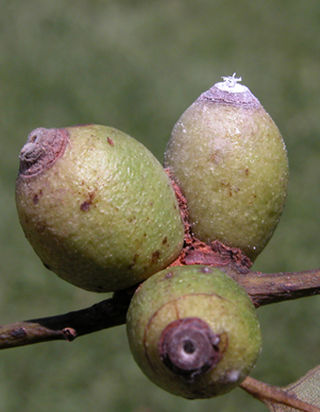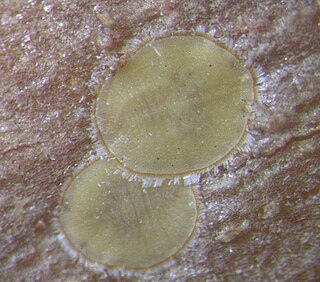
Scale insects are small insects of the order Hemiptera, suborder Sternorrhyncha. Of dramatically variable appearance and extreme sexual dimorphism, they comprise the infraorder Coccomorpha which is considered a more convenient grouping than the superfamily Coccoidea due to taxonomic uncertainties. Adult females typically have soft bodies and no limbs, and are concealed underneath domed scales, extruding quantities of wax for protection. Some species are hermaphroditic, with a combined ovotestis instead of separate ovaries and testes. Males, in the species where they occur, have legs and sometimes wings, and resemble small flies. Scale insects are herbivores, piercing plant tissues with their mouthparts and remaining in one place, feeding on sap. The excess fluid they imbibe is secreted as honeydew on which sooty mold tends to grow. The insects often have a mutualistic relationship with ants, which feed on the honeydew and protect them from predators. There are about 8,000 described species.

Casuarina, also known as she-oak, Australian pine and native pine, is a genus of flowering plants in the family Casuarinaceae, and is native to Australia, the Indian subcontinent, Southeast Asia, islands of the western Pacific Ocean, and eastern Africa.

The Sternorrhyncha suborder of the Hemiptera contains the aphids, whiteflies, and scale insects, groups which were traditionally included in the now-obsolete order "Homoptera". "Sternorrhyncha" refers to the rearward position of the mouthparts relative to the head.

Aspidiotus is a genus of armoured scale insects. It includes several agricultural and horticultural pests.

Diaspididae is the largest family of scale insects with over 2650 described species in around 400 genera. As with all scale insects, the female produces a waxy protective scale beneath which it feeds on its host plant. Diaspidid scales are far more substantial than those of most other families, incorporating the exuviae from the first two nymphal instars and sometimes faecal matter and fragments of the host plant. These can be complex and extremely waterproof structures rather resembling a suit of armor. For this reason these insects are commonly referred to as armored scale insects. As it is so robust and firmly attached to the host plant, the scale often persists long after the insect has died.

Eriococcidae is a family of scale insects in the order Hemiptera. They are commonly known as felt scales or eriococcids. As of 2023, there are 109 genera and 681 species. Each species is usually specific to a different plant host, or closely related group of hosts.

Halimococcidae is a family of scale insects in the order Hemiptera. Members of the family are commonly known as pupillarial palm scales or halimococcids. Most species are found on the leaves of palm trees where they suck sap, but some species occur on Pandanus. The family was named by Brown and McKenzie in 1962 and includes five known genera and twenty one species.

Beesoniidae is a family of scale insects commonly known as beesoniids. They typically cause galls on their plant hosts. Members of this family mostly come from southern Asia. The family name comes from the type genus Beesonia which is named after the entomologist C.F.C. Beeson who obtained the specimens from which they were described and named.
Phenacoleachiidae is a family of scale insects commonly known as the phenacoleachiids. They are found only in the South Island of New Zealand, and on certain offshore islands. There are two species in a single genus.
Putoidae is a family of scale insects commonly known as giant mealybugs or putoids The genus name Macrocerococcus has also been used but it is now considered to be a synonym of Puto. The genus Puto was formerly classified as a member of the Pseudococcidae; however, it so significantly differed from the rest of the Pseudococcidae that it was accorded its own family Putoidae.
Morganella is a genus of scale insects in the family Diaspididae. Morganella longispina is the type species.

Aulacaspis, is a scale insect genus in the family Diaspididae. The type species is Aulacaspis rosae.

Chionaspidina is a subtribe of armored scale insects established by Borchenius. But unlike many of the subtribes recognized by Borchenius, this one was found to be morphologically valid by Takagi. Similarly, in molecular analysis, Andersen et al. found a clade roughly corresponding to the subtribe Chionaspidina.
Kuwanaspidina is a subtribe of armored scale insects. They feed on bamboo.
Rugaspidiotina is an obsolete subtribe of armored scale insects. It was established by Balachowsky in 1949 to accept those Diaspidinae which had rugaspidiotine characteristics as exemplified by genus Rugaspidiotus MacGillivray, species Rugaspidiotus arizonicus, and was moved from the Odonaspidini to the Diaspidini by Borchsenius. It was raised to tribe status as Rugaspidiotini. However, close examination of species assigned to the Rugaspidiotini showed that the rugaspidiotine characteristics convergently evolved in different groups of diaspidids. Rugaspidiotini and Rugaspidiotina are now regarded as obsolete groupings.

Apiomorpha is a genus of scale insect that induces galls on species of Eucalyptus. Galls are initiated by first-instar nymphs (crawlers) on new plant growth and, when mature, the galls exhibit marked sexual dimorphism. Those induced by females are among the largest and most spectacular of arthropod-induced galls whereas those of males are small and most are tubular. Apiomorpha is known only from Australia and New Guinea although its host, Eucalyptus, has a wider distribution into Indonesia as well.

Cylindrococcus is a genus of scale insects that induces galls on plants of the genus Allocasuarina. There are two described species of Cylindrococcus, both of which occur only in Australia. The galls of adult females look somewhat similar to the cone-like "fruit" of the host plant and might be mistaken for such.

Callococcus is a genus of Australian scale insect that feeds on species of Leptospermum, Hypocalymma, Kunzea and some other members of the tribes Chamelaucieae and Leptospermeae in the myrtle family Myrtaceae. Callococcus leptospermi induces stem-swelling galls on some species of Leptospermum, and it is considered to be a potential biological control agent of Leptospermum laevigatum in South Africa. The other described species of Callococcus do not induce galls.

Lachnodius is a genus of eriococcid scales, or felt scale insects, in the family Eriococcidae. There are at least 10 described species in Lachnodius, found in Australia.
Hopea novoguineensis is a rainforest tree species in the Dipterocarpaceae family. It is found in New Guinea and on Halmahera, Maluku Province, Indonesia. The tree produces good timber.












